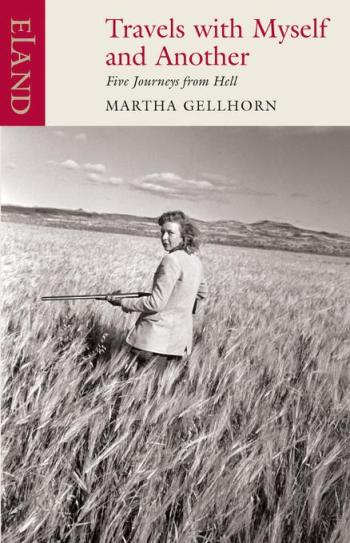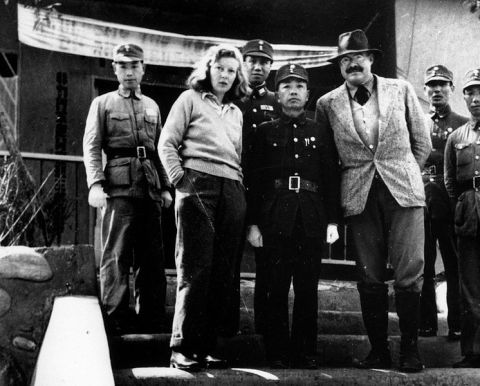I was walking down Long Acre with my boyfriend; we wandered into Stanford’s to ogle maps and travel books. After having a wander we came to the books table back near the entrance. I was attracted to the dated-in-a-good-way cover of Travels With Myself and Another (from Eland), not only because of the layout and title but also because of the incredible photo of the author. Martha Gellhorn, in black and white, turning back to the camera with a frown and windswept hair, holding a gun and wearing what appears to be tweed in a field of long grass. She looked bloody amazing and I wanted to know more.

The opening paragraph of chapter one also enticed me:
I was seized by the idea of this book while sitting on a rotten little beach at the western tip of Crete, flanked by a waterlogged shoe and a rusted potty. Around me, the litter of our species. I had the depressed feeling that I spent my life doing this sort of thing and might well end my days here. This is the traveller’s deep dark night of the soul and can happen anywhere at any hour.
Gellhorn writes with a very likeable sense of dark humour and a healthy ‘buck up’ attitude that keeps her going through her worst trials of unbearable weather, transportation, lodgings, illness… and the rest. When having to deal with a useless guide, driving around Kenya and Uganda, she repeatedly tell him to buck up, as she wrangles with the Land Rover (he was meant to drive but refused to do so) and takes charge of the trip. Suffice to say I think she’s pretty awesome.
Martha Gellhorn had what I would call a remarkable life. Born in St Louis, Missouri, in 1908, she dropped out of university (in 1928) to forge a successful career in journalism. She wrote for a host of American publications as a foreign correspondent, and reported on the rise of Hitler as well as the Spanish Civil War, which she covered with her later husband, Ernest Hemingway. They were married for the duration of the Second World War, during which Gellhorn threw herself into the action. I was amazed to read in her author profile in my copy of Travels that “after Hemingway stole her accreditation, she stowed away on a hospital ship on 7th June 1944 and went ashore during the Normandy invasion to help collect wounded men” – according to Wikipedia she posed as a stretcher-bearer so that she could follow “the war wherever [she] could reach it.” No mean feat. She was also one of the first journalists to report on the liberation of the Dachau concentration camp, from the scene.
Her five Journeys From Hell are truly spectacular. In 1941 she travelled to China to document the Sino-Japanese war and the effects of WW2 on China. This section of the book is the most blackly comic as Gellhorn describes the appalling places they have to stay and the incredibly dangerous flights in small aircrafts, and the men who fly them. She travelled with an “Unwilling Companion, hereinafter referred to as UC”, who I soon realised was Hemingway. They had been married a few months before and this trip was in effect their honeymoon. Their compared experiences of the trip create much of the humour, as he is happy to drink, smoke, and chat with locals, while she is trying to get material for her article and remember important details, as well as deal with guides and officials that barely speak English. The fantastic quote on the back cover perfectly embodies Gellhorn’s feelings on this trip:
The door [of their accommodation for the night] opened onto the street and the smell thereof. The mosquitoes were competing with the flies and losing… I lay on the boards, a foot off the floor, and said in the darkness, ‘I wish to die.’

I admired Gellhorn throughout the book, and particularly in the long section detailing her travels, this time recreational, in Africa, in 1962. In the penultimate year of her second marriage, Gellhorn took herself off to Africa to try and discover the real place hidden behind news reports. In both West and East Africa she meets a huge cast of diverse characters, including many “whites” who have lived in Africa for varying lengths of time. She found that even those who had lived there for more than a decade (including one married to an African and with mixed race children) still claimed to not at all understand the “blacks” and declared them to be “lower” in several ways than themselves. While Gellhorn herself finds many cultural and social differences between herself and the African people, she is not outright racist towards them and seems to be made uncomfortable by those who express such views. More than once she wonders if so-called “white civilisation” is any better than half-naked tribes in mud huts. She concludes the African people would most likely be better off if they were left to live without the influence of Europeans and Americans. That said, she views many of the African communities she visits to have gone largely unchanged in hundreds of years and does not credit them to have invented on their own, over time, any of the “white” modern inventions that colonialism has brought them, such as electricity and cars. I wasn’t sure what to make of this – but concluded that in general Gellhorn had a better attitude towards the African people than most other white people she meets, and at least respected their ways of doing things.
Travels With Myself and Another also covers “horror journeys” to the Caribbean during WW2, as well as Russia and Israel in later years, and Bali in March 1946 for the surrender of the Japanese troops stationed there – each fruitful in their own ways and described with lashings of sardonic Gellhorn humour and world-weariness. I liked Martha Gellhorn immensely throughout the course of this travel book/travelogue – whatever it may be defined as – and have decided to explore more of her writing, both fiction (five novels, fourteen novellas and two collections of short stories) as well as anthologies of her journalism. Her author bio in this book ends with:
She was a woman of strong opinions and incredible energy. Though she turned down reporting on the Bosnian war in her 80s, saying she wasn’t nimble enough, she flew to Brazil at the age of eighty-seven to research and write an article about the murder of street children. Touch-typing although she could barely see, she was driven by a compassion for the powerless and a curiosity undimmed by age.
What a woman.
*
Travels With Myself and Another was originally published by Allen Lane in 1978, by Eland in 1982, and reprinted (also by Eland) in 2002 and 2007.


[…] last year and I read quite a lot about it at the time. I like a good memoir, and since reading Martha Gellhorn for the first time last year I’ve wanted to read more travel memoirs and travelogues, and […]
LikeLike
[…] was a journalist willing to throw herself into any situation, or journey, to research an article. This book covers her adventures in China during World War Two with her then-husband Ernest Hemingway, as well […]
LikeLike
[…] but I instantly wanted to read the book as well as see the film. After having enjoyed Wild and Travels with Myself and Another so much, I want to read more travel writing, and I liked the independence and bravery of […]
LikeLike